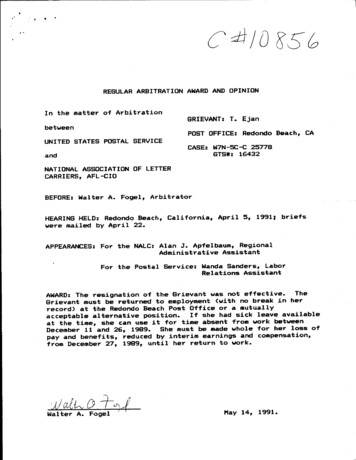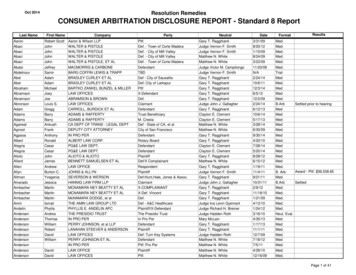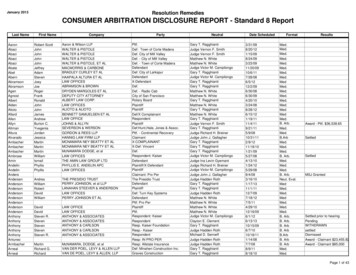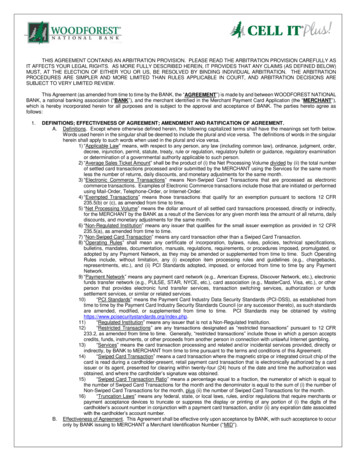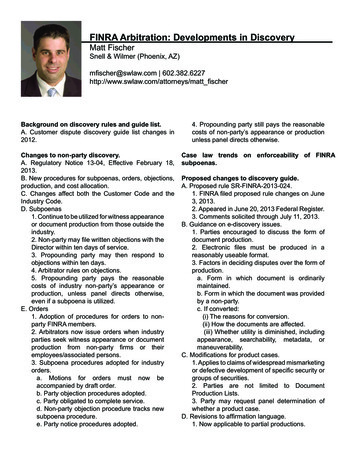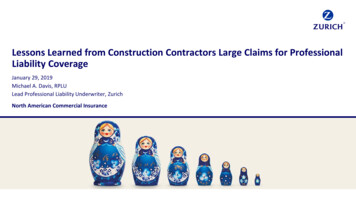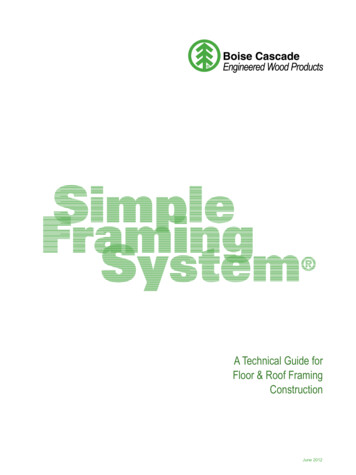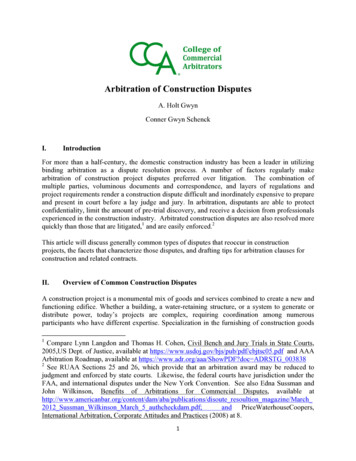
Transcription
Arbitration of Construction DisputesA. Holt GwynConner Gwyn SchenckI.IntroductionFor more than a half-century, the domestic construction industry has been a leader in utilizingbinding arbitration as a dispute resolution process. A number of factors regularly makearbitration of construction project disputes preferred over litigation. The combination ofmultiple parties, voluminous documents and correspondence, and layers of regulations andproject requirements render a construction dispute difficult and inordinately expensive to prepareand present in court before a lay judge and jury. In arbitration, disputants are able to protectconfidentiality, limit the amount of pre-trial discovery, and receive a decision from professionalsexperienced in the construction industry. Arbitrated construction disputes are also resolved morequickly than those that are litigated,1 and are easily enforced.2This article will discuss generally common types of disputes that reoccur in constructionprojects, the facets that characterize those disputes, and drafting tips for arbitration clauses forconstruction and related contracts.II.Overview of Common Construction DisputesA construction project is a monumental mix of goods and services combined to create a new andfunctioning edifice. Whether a building, a water-retaining structure, or a system to generate ordistribute power, today’s projects are complex, requiring coordination among numerousparticipants who have different expertise. Specialization in the furnishing of construction goods1Compare Lynn Langdon and Thomas H. Cohen, Civil Bench and Jury Trials in State Courts,2005,US Dept. of Justice, available at https://www.usdoj.gov/bjs/pub/pdf/cbjtsc05.pdf and AAAArbitration Roadmap, available at https://www.adr.org/aaa/ShowPDF?doc ADRSTG 0038382See RUAA Sections 25 and 26, which provide that an arbitration award may be reduced tojudgment and enforced by state courts. Likewise, the federal courts have jurisdiction under theFAA, and international disputes under the New York Convention. See also Edna Sussman andJohn Wilkinson, Benefits of Arbitrations for Commercial Disputes, available cations/disoute resoultion magazine/March2012 Sussman Wilkinson March 5 authcheckdam.pdf;and PriceWaterhouseCoopers,International Arbitration, Corporate Attitudes and Practices (2008) at 8.1
and services permeates the construction industry. We still build with bricks and mortar, but werely upon sophisticated components installed by specialists using delivery systems with evermore-complex risk allocations. Amenities found in today’s starter houses make them complexstructures in comparison to the multistory office buildings of the 1930s.Construction disputes regularly include thorny questions of what efforts—design, construction,or both—are at issue; whose scope of work is involved; the terms of all contracts andsubcontracts relating to the affected area or event; the scope and reach of regulations, buildingcodes, or other over-arching project requirements, and so on. It is an area that commercialarbitration by industry professionals is well-suited.III.Construction Industry Developments and Trends that Contribute to DisputesConstruction projects in the 21st Century are high-tech. Commercial office buildings, forinstance, are replete with energy-saving, “smart” systems which govern the building’s ambientconditions and the safety and security of its inhabitants. As construction projects become morecomplex, they cost more. Owners, like all consumers, resist higher costs.3 This puts pressure onconstruction design, especially the design of components. Cost concerns filter the design ofevery construction material and component. And because speed of installation is a function ofoverall cost, price also affects components’ means and methods of application.Designers of construction materials and components continually look for ways to make productsthat cost less, are quicker and easier to install, have a more desirable appearance, and performbetter than last year’s models.4 But as construction component design is revisited and revised inthe name of cost, performance characteristics are affected. When the performance criteria ofcomponents are materially altered, the performance of major building systems may becompromised. The redundancies of conservative design that were de rigueur for buildings indecades past too often play second fiddle to the latest bells and whistles of convenience.The increasing complexity of buildings has challenged the architect’s role. Architects formerlywere the arbiters of component design and selection. This has changed, especially in thecommercial and industrial construction market. Product design and, recently, system design havedevolved to component manufacturers. No longer is the architect the project’s mostknowledgeable leader. As observed by a leading Columbia University professor, by the end ofthe 1970s architects came to know less and less about more and more until some were said “toknow nothing about everything.”33Many off-the-shelf consumer goods decrease in price as availability increases. Consumers ofmany goods—especially newer technology goods—have become accustomed to getting more forthe same price as last year, or even more for a lesser price than last year.4A quantifiable improvement in any of these characteristics will increase market share.3MARIO SALVADORI, WHY BUILDINGS STAND UP: THE STRENGTH OF ARCHITECTURE 24 (1980).No longer is the architect capable of the expertise required by the court in Hubert v. Aiken, 2N.Y.S. 711 (Ct. Com. Pl. 1888), aff’d, 25 N.E. 954 (N.Y. 1890) (“he is an expert in carpentry,cements, mortar, in the strength of materials new conveniences ”).2
Construction design in the 21st Century is more and more led by designers working forcomponent manufacturers. Selection and coordination of building components, long the provinceof design professionals, are in today’s world being usurped by contractors and componentmanufacturers. Through “value engineering” or outright design delegation,4 architects defer tocomponent and system designers. Contractor-led design/build arrangements often relegate thearchitect to backroom subcontractor status.The right of component selection carries with it the responsibility to coordinate the chosenproducts with the building’s structure and complementing systems. It is in this task that designprofessionals of record can play a significant role—to ensure that their overall project design isnot miss-matched. Nevertheless, design professionals of record (and their insurance carriers)today also hand off much of their former role, if not all of their responsibility.5 To a larger andlarger degree, construction services have become coordinated deliveries and installation ofproducts.Specialization in the construction industry has also morphed the contract process. Virtually allprojects have dozens of contractual arrangements. Specialized equipment must be furnished andinstalled by ever-more-specialized subcontractors and suppliers. The traditional design-bid-buildproject delivery method is but one of many available contractual vehicles. Owners can chooseamong construction managers (agent and at-risk), multi-prime contractors, design-builders, jointventures, “lean” construction, integrated project delivery, and so on—the ability to customize theprocess grows every year.6 But there is one industry constant—there are more and more entitiesproviding specialized goods and services.4The American Institute of Architects’ standard general conditions of the contract betweenowner and contractor now explicitly allow the delegation of the architect’s design responsibilityto the general contractor and its subcontractors. See AIA Document A201–2007, GeneralConditions of the Contract for Construction ¶§ 3.12.10.5Design professionals “of record” retain liability, especially to their clients, for adequate andcode-compliant design, whether the design professional performs the work or delegates it toothers. See 5 PHILIP L. BRUNER & PATRICK J. O’CONNOR, JR., BRUNER AND O’CONNOR ONCONSTRUCTION LAW §§ 17:70-71, 17:73 (2009). See also Johnson v. Salem Title Co., 425 P.2d519 (Or. 1967) (structural engineering requirements were nondelegable, even to a professionalengineer). The result is different if the design professional never had the responsibility as part ofits scope of services. See Aleutian Constructors v. United States, 24 Cl. Ct. 372 (1991)(specifications required contractor to design and build roof); Mudgett v. Marshall, 574 A.2d 867(Me. 1990) (error of structural engineer hired by design-build contractor not imputed to owner’sdesign professional not hired to design building).6The American Institute of Architects’ Standard Form of Agreement Between Owner andArchitect, AIA Document B101-2007 (formerly B151–1997) Standard Form of AgreementBetween Owner and Architect), provides owners a menu of architectural services from which tochoose. See also AIA Document B102–2007 (formerly B141–1997 Part 1) Standard FormAgreement Between Owner and Architect without a Predefined Scope of Architect’s Servicesand AIA Document B201–2007 (formerly B141–1997 Part 2) Standard Form of Architect’sServices: Design and Construction Contract Administration.3
The specialization of construction goods and services, and reliance upon newly-designed,prefabricated construction products,7 has strained the law of contracts. When something goeswrong on a construction site, or when the completed edifice does not meet expectations, there areusually a number of entities with a hand in the cause. Products that perform well in one settingmay, for instance, lack the robustness to weather ambient conditions in another place.As product diversification expands, the importance of selecting complementary constructioncomponents has increased. It is now as significant to select and coordinate as it is to installproperly. When problems occur, are they the fault of the design professional, the installer, themanufacturer, the supplier, the maintenance team, or all of the above? Getting to the bottom of aconstruction problem often requires a detailed investigation, and a good deal of finger-pointingregrettably ensues. Major responsibility may lie far down, or even outside, the project contractualchain.In prior decades, a contractor would directly employ different types of skilled labor for a job(carpenters, masons, iron workers, pipe fitters, concrete finishers, etc.). Today’s builder retainsseparate subcontractors and suppliers, each with its own separate scope of work. When problemsdevelop today, claims are often passed among multiple entities, with multiple contractualarrangements. For many issues, the common law contract causes of action can be cumbersome inthe extreme. If a problem takes several years to manifest itself, if contractual responsibilities forthe work are not the same up and down the contractual chain of specialization, or if there aregaps in the scope of and responsibilities for the completed work, damages may occur for whichthere is no common law contract remedy. Into this fertile field, the seeds of tort law have takenroot. Many construction disputes now include claims of professional negligence and designdeficiencies, as well as construction-related issues including defects and delays. And becausedesign responsibility is located throughout the contractual chain, a number of different parties areoften involved.Contract law has adapted in several areas to market conditions. Warranties from manufacturersof certain goods (typically finished goods, specially-designed equipment, and appliances) allowaffected parties to leapfrog gaps and broken links in the project’s contractual chain.8 There isalso a federal statutory remedy for certain types of defective household goods, but this remedydoes not carry over to commercial projects—it is available only to household consumers.9 Under7Many of these products are designed to meet a specific price point to achieve market share.See, e.g., Groppel Co. v. United States Gypsum Co., 616 S.W.2d 49 (Mo. Ct. App. 1981); see also authorities cited at West’s343SALES, k255, k427.9The Magnuson-Moss Act, 15 U.S.C.A. § 2301 et seq. (2002), provides consumers withstatutory remedies for breach of a manufacturer’s or vendor’s written or implied warranty of aconsumer product. The Act also provides certain minimum requirements for written warranties.Upon establishing that the warranty was breached, the consumer may elect the remedy of refund,repair, or replacement, and may recover attorney’s fees if he prevails. The Act applies topersonal, family, or household products, but may include “building materials” such as paneling,siding, or storm windows, when purchased in connection with remodeling a home. In one of theleading cases, the Act was applied to roofing materials. Muchisky v. Frederic Roofing Co., 838S.W.2d 74 (Mo. Ct. App. 1992) (affirming verdict, and award of attorney’s fees, in favor of84
the common law of contracts, privity reigns. Further, under the common law, providers ofservices and labor were often immune from responsibility once their work was accomplished andaccepted.10Construction disputes, therefore, regularly include thorny questions of what types of services—design, construction, or both—are at issue; whose scope of work is involved; the terms of allcontracts and subcontracts relating to the affected area or event; the scope and reach ofregulations, building code or other over-arching project requirements, and so on. It is an area thatcommercial arbitration by industry professionals is well-suited.IV.General Types of Construction DisputesThere are two broad areas of construction disputes: those involving defects and deficiencies(design and construction), and those involving time and extra costs or backcharges claimed butdisputed.Defect and deficiency claims involve costs of correction, diminuti
See also AIA Document B102–2007 (formerly B141–1997 Part 1) Standard Form Agreement Between Owner and Architect without a Predefined Scope of Architect’s Services and AIA Document B201–2007 (formerly B141–1997 Part 2) Standard Form of Architect’s



